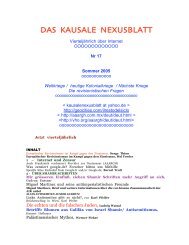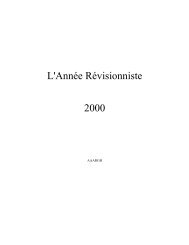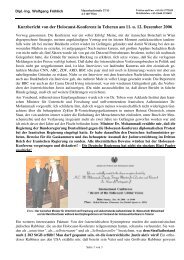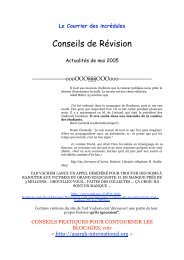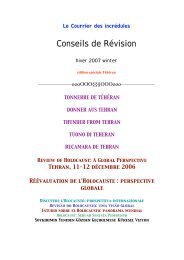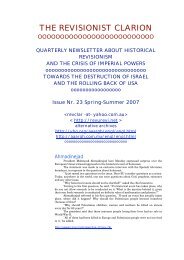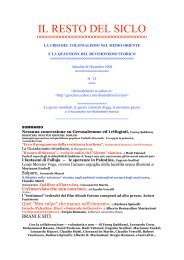Numéro 60--- ÃTà 2007 - Vho
Numéro 60--- ÃTà 2007 - Vho
Numéro 60--- ÃTà 2007 - Vho
You also want an ePaper? Increase the reach of your titles
YUMPU automatically turns print PDFs into web optimized ePapers that Google loves.
GAZETTE DU GOLFE ET DES BANLIEUES / <strong>60</strong> / ÉTÉ <strong>2007</strong><br />
the landscape were shaped and plowed by farmers through generations. This is especially<br />
apparent in the Jerusalem hills, the shfela (Judean lowlands) and the Galilee.<br />
Hundreds of agricultural structures that once served a magnificent and successful<br />
network of irrigation in the Palestinian village of Ein Kerem can still be found around Ein<br />
Kerem, now a Jerusalem neighborhood. On the hills of Beit Nataf adjacent to Beit Shemesh,<br />
an area which the Israel Nature and National Parks Protection Authority (INNPA) wants to<br />
turn into a national park, the orchards of the Palestinian village that once stood there<br />
continue to shape the landscape. Historians who are very critical of the Zionist movement,<br />
such as Dr. Ilan Pappe, claim that disregarding the existence of Palestinian villages is part of<br />
a deliberate effort to erase their history in favor of creating a new one that suits the Zionist<br />
narrative of a country that was barren, and only flourished thanks to groups like the JNF. In<br />
a study he published, Pappe analyzes the information that JNF provides on several sites,<br />
including the Biria Forest, the Jerusalem Forest, the area of Ramat Menashe and the Sataf<br />
site near Jerusalem. "The Palestinian orchards are presented as a product of nature, and<br />
the history of Palestine is relocated to the period of the Bible and the Talmud," he writes in<br />
his discussion of the site of the village of Ein Zeitun in the Biria Forest.<br />
Pappe also points out that the JNF publishes information about unique sites in the<br />
Jerusalem Forest and Sataf that testify to the extensive agricultural activity in the region. The<br />
information emphasizes the presence of terraces, describing them as ancient, even if they<br />
were built and maintained by Palestinian villages. A recent study conducted by Noga<br />
Kadman (as part of her studies in the Department of Peace and Development Research at<br />
Goteborg University in Sweden, under the tutelage of Prof. Oren Yiftachel of Ben-Gurion<br />
University of the Negev), found about 86 Palestinian villages inside the JNF forests -<br />
sites she describes as "emptied." Most of the sites have directional signs, but only 15<br />
percent of them mention the villages by their Arab name. Most of the pamphlets and<br />
brochures do not even mention the villages. And in half of the literature where the villages<br />
are mentioned, the fact that their inhabitants were Arabs is elided. Only in one case did it<br />
say how many people lived in the village, and only in isolated instances is there any<br />
discussion of the lives of the inhabitants. "In most cases, the fact that the villages ceased<br />
to exist is not specifically mentioned," writes Kadman. "This can be concluded from the text<br />
regarding most of the villages, which are called 'abandoned,' and are described as ruins or<br />
remains, or mentioned in the past tense." Bronstein has already submitted Kadman's list of<br />
villages to the JNF. He also intends to approach INNPA and ask that it, too, mention the<br />
location of abandoned villages in nature reserves and national parks. The INNPA said in<br />
response that no site is given preference or ignored because of national or religious<br />
affiliation, and that there are several Palestinian villages that are mentioned in signs and in<br />
the informational material prepared by the authority.<br />
Yehuda Ziv, who heads the Government Names Committee's subcommittee for<br />
community names, and is considered one of the leading experts in Israel in the field,<br />
supports the idea of marking the location of abandoned Arab villages. "I support the<br />
mention of the Arab names of various sites, including villages, streams and other places,<br />
and I think that they should not have been erased from the map," says Ziv. "One reason is<br />
that these names often teach us about the country's Jewish past. There is an additional<br />
reason, and that is the fact that these names teach us the history of the country and its<br />
landscape. I claimed that original Arab names of existing communities should be added as<br />
part of a first map of Israel in Arabic being prepared by the Israel Mapping Center, but I was<br />
told that there is no room for that. However, regarding destroyed villages, I think that we<br />
should make do simply with a mention of the name of the village."<br />
http://www.haaretz.com/hasen/spages/870315.html<br />
— 45 —



